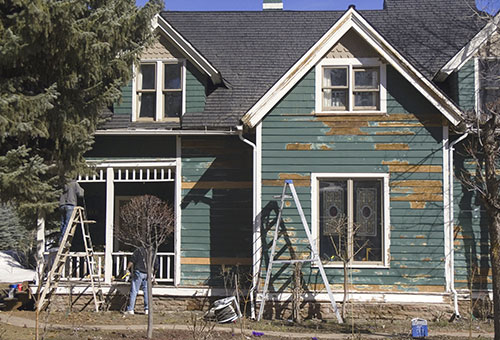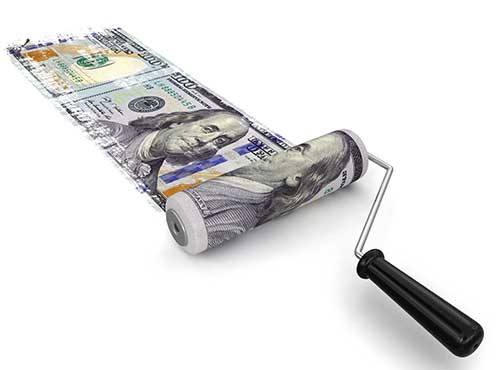Painting Over Old Exterior Paint
 Is your home ready for a coat of paint? Paints serve a far more critical purpose than just increase the curb appeal. It helps to protect your house from the elements.
Is your home ready for a coat of paint? Paints serve a far more critical purpose than just increase the curb appeal. It helps to protect your house from the elements.
The most important rules to follow for exterior painting are to prepare the surfaces well and to buy the best possible paint within your budget.
Understanding how to prep works to increase the longevity of your painting project.
This article brings you the inside scoop on painting over old exterior paint, painting old houses, prep work for previously painted surfaces, the cost involved, and much more.
How Do I Apply New Paint Over Old Paint?
It shouldn’t be challenging to paint again, considering that the surface has been painted already once. Considering that you may want to prep and prime, here’s how you paint any wall:
- Wash the walls free of dust and grease.
- Fill the cracks, gaps, and holes with fillers, preferably a flexible filler.
- In case you are filling, make sure you sand and apply a primer to prevent a patchy look.
- Apply at least two coats of the new paint.
- If you are going for a lighter color, paint a basic white matte emulsion as the first coat to prevent the former color from showing through.
Prime or Not to Prime
Priming helps seal and achieve a smooth surface for better adhesion. But is it necessary to use a primer every time you paint?
You do not need a primer:
- If the new paint is the same color as the old one and the wall is smooth and clean.
- Both the paint, the old and new, should be of the same type, i.e., oil-based.
- The walls are the same color or at least close to each other.
You need a primer:
- You are covering latex paint with oil-based paint. Oil paints will not adhere to latex paints.
- If your wall is in bad condition and you are looking to cover it up, a primer will help to mask them to a large extent.
- If the new coat of paint is shades lighter than the darker existing paint;
How to Paint an Old House?
Exterior paint protects your house against sun, wind, rain, and other environmental factors until it starts cracking and peeling. Hence it makes sense to plan way ahead before painting.
Here’s how you paint an old house with quite a few coats of paint on it.
- Wash down the exterior with pressure or power washer prior to painting, first with a soap solution and clean water. New paint doesn’t adhere to dirt, mildew, or peeling paint.
- Use a primer on the surface only if needed. Alternatively, you could just apply primer to problem areas such as bare wood, rust-stained surfaces, etc.,
- Cover the doors, windows, and fixtures with plastic sheets and painter’s tape. Place drop cloths on the ground, along the walls.
- Use the medium of painting, brush or sprayer, or roller to paint a flat or eggshell color. Depending on the intensity, you may want to apply one or two coats.
- Start painting at the top and work your way down.
Prep an Old House for Painting
Prep work makes for 80% of the painting. Quality prep work makes the paint go on flawlessly, and the wall looks perfect.
- Mix gallon water with a cup of chlorine bleach and 1 cup of phosphate-free cleaner. Use this mixture to wash, scrub and rinse down the walls.
- If the paint has peeled, bubbled, or blistered, scrape the peeled sections.
- Paints in houses older built before 1978 may contain lead. You may want to proceed with care and take necessary precautions.
- Use 50- or 80- grit sandpaper to smooth the boundary between the bare wood and the paint.
- Fill in the minor cracks, gaps, dents, and holes with fillers. Replace the rotting pieces.
- Use acrylic primers for the exterior. However, for cedar and redwood, use oil-based coatings to lock in the extractives.
- Use a metal primer over the exposed nail heads to prevent rusting.
- Once the primer is dry, caulk the small joints in the trim and siding.
Cost to Paint Old Houses
 The cost of painting an old house depends on the number of stories, conditions, and ease of access. You may have to pay $3 – $4 per square foot.
The cost of painting an old house depends on the number of stories, conditions, and ease of access. You may have to pay $3 – $4 per square foot.
- 500 sq ft: $1,000 – $1,500 for exterior and $750 – $1,500 for interior
- 1 Story 1,000 sq ft: $1,000 – $3,000 for exterior and $1,500 – $3,000 for interior
- 2 Story 2,500 sq ft: $3,000 – $5,000 for exterior and $3,750 – $7,500 for interior
- 3-4 Story 4,000 sq ft: $4,000 – $7,000 for exterior and $6,000 – $12,000 for interior
Tips for Painting Old Houses
Painting older homes comes with its own set of challenges that make the project seem more daunting. Here are a few tips to help make the situation more manageable.
- Thoroughly inspect the surfaces to be painted and make a note of the prep work needed.
- Use the right tools and paint for each surface like plaster walls, wood paneling, exposed brick, etc.
- Take a piece of peeling paint to home improvement stores for color matching.
- Ensure that you paint in dry weather. Paint doesn’t do well in humidity and rain.
- Old wood does better with a brush application. You can then go over with a roller.
- Coating bare wood with a water-repellant helps prevent the growth of mildew and increases the life span of the paint.
- Hire a professional for old houses since they understand the challenges that come with the territory.
Tips for Painting Exterior Wood Trim
 Exterior trim includes the molding around windows, doors, and corners. Often it is not the same color as the siding. Here are some tips and tricks to follow when painting exterior trim.
Exterior trim includes the molding around windows, doors, and corners. Often it is not the same color as the siding. Here are some tips and tricks to follow when painting exterior trim.
- Choose a semi-gloss for your exterior trim. With a subtle shine, it adds a certain degree of visual contrast.
- Ensure that you have a ladder set up for safety reasons.
- Prep the trim by scraping the paint using a scraper.
- Fill the holes using a filler and lightly sand the surfaces.
- Paint doesn’t adhere to glossy surfaces, so make sure you have a fast-drying primer.
- An angled brush works the best and gets you to reach the hard-to-reach corners of the trim.
Prep Painted Wood for Painting
The finished look of the wood depends on the prep work.
- Scrape the peeling paint and strip the entire surface of its paint. Follow by sanding with 180 grit sandpaper.
- If there is no peeling paint, use a 280 grit and sand the surface.
- Prepare a solution of warm water with TSP. Dip a cloth, squeeze it dry and wipe down the wood to remove oil, dirt, and grime. Rinse with clean, warm water.
- Fill in large cracks and gaps with a wood filler.
- Use a random orbital sander and a 180 grit sandpaper to create a smooth area.
- Wipe the dust with a damp cloth.
- Finally, apply a primer to the area.
Can I Paint Over Exterior Peeling Paint
No! Painting over peeling paint doesn’t result in a smooth and professional finish. You need to strip and scrape the paint before priming and painting the surface.
Which is Better to Paint Exterior: Spray or Roll?
Many-a-painter in recent times prefers a sprayer to paint the exterior due to the speed. You can get the work faster and get the project done much quicker, reducing the labor charges.
However, the paint goes on as a thin layer and is difficult to control, especially with amateurs. You may have to shroud the cars, gutters, plants, etc., in the vicinity with fabric drop cloths.
Rollers, on the other hand, give a high-quality finish to the project. The paint goes on thick and precise, which prevents overspray.
On comparing the both, roller fares better than a sprayer due to the quality of the job.
Best Time of the Year to Paint Exterior of House
A quality paint job requires minimal rain, little humidity, and not many temperature fluctuations from day to night. And as such, early summer and early falls are the best time for exterior painting. The weather conditions ensure that the paint goes on smoothly with the chance to dry and cure properly.
How Long Does an Exterior Paint Job Last?
While there is no set timeline, it is safer to paint your house every 5-10 years. However, this varies depending on the material:
- Wood Siding – 3-7 years
- Stucco – 5-6 years
- Brick – 15-20 years
Can I Paint Over Old Paint Without Sanding
If the existing paint is of the same type and the wall is in good condition, you can go ahead and paint without sanding.
However, when it comes to wood, you may have to sand for proper adhesion. However, you can also skip the sanding process and make do with a primer.
Conclusion
Exterior painting is a pretty big job, especially if it is an old house. To ensure a quality paint job that will last for years, you need to have a proper painting process that includes extensive prep work.
Prepping involves scraping off old paint, sanding, and priming. It will save you money, time, and effort in the near future.
Having said that, not all surfaces require priming. If your walls are in good condition, you need not apply a primer; just go ahead with two coats of paint. Make sure that you paint the large areas first and the details towards the end. Furthermore, ensure that you have good-quality brushes and roller covers that can increase efficiency.
 If you are looking for a stress-free exterior painting experience, you need to choose the right contractors – contact Nelson Greer Painting Contractors for your FREE quote today. We will make sure that your home is properly painted inside and out to last you for years to come. With over 220 years of experience in our company’s history, you’ll love what we can do with our professional painting contractors.
If you are looking for a stress-free exterior painting experience, you need to choose the right contractors – contact Nelson Greer Painting Contractors for your FREE quote today. We will make sure that your home is properly painted inside and out to last you for years to come. With over 220 years of experience in our company’s history, you’ll love what we can do with our professional painting contractors.
Categories
- Church Painting (1)
- Commercial Painting (14)
- Exterior Painting (6)
- Interior Painting (2)
- FAQ (1)
- Floor Coating & Sealing (3)
- General (13)
- Industrial Painting (1)
- Metal Painting (1)
- Paint Prep (3)
- Painting Contractors (4)
- Pool Deck Epoxy (1)
- Residential Painting (32)
- Baseboards & Trim (2)
- Cost (3)
- Exterior Painting (8)
- Interior Painting (7)
- Tips (2)
- Walls (6)
- Roof Replacement (1)